How to Cite | Publication History | PlumX Article Matrix
Poomaruthai Masilamani, Venugopal Rajanbabu
Venugopal Rajanbabu and Subramanian Venkatesan
and Subramanian Venkatesan
Anbil Dharmalingam Agricultural College and Research Institute, TNAU, Tiruchirappalli -620 027, Tamil Nadu, India.
Corresponding Author E-mail: masil_mahesh@yahoo.com
DOI : http://dx.doi.org/10.13005/bbra/2871
ABSTRACT:
The effect of drupe size on in vivo and in vitro germination and its dormancy mechanism in teak have been studied in this paper. Teak drupes were size graded to five categories namely very large with more than 15 mm, large with 13 to <15 mm, medium with 11 to <13 mm, small with 9 to <11 mm and very small with less than 9 mm of diameter. Under in vivo pot culture condition very low germination percent of drupes was observed. It was observed that very large size drupe had highest 100 drupe weight, 100 true seed weight and seed filling capacity, but it was negatively correlated with in vivo germination of teak drupes. When true seeds isolated from the drupes were grown under in vitro condition in half strength MS medium the germination percent was significantly increased up to 54.1. True seeds obtained from small size graded drupes recorded highest germination per cent in MS media. This showed that the drupe size did not play major role in the germination and early growth in teak. Very small size graded drupes have low seed filling capacity, and it leads to decrease the germination percent. Poor germination of drupes showed the presence of mechanical and physiological dormancy in drupes. Similarly, the presence of morphological and embryo dormancy in teak may limit the true seed germination potential to 54.1 per cent. In addition, in vitro germination of true seeds will be a promising approach to obtain large number of saplings in teak.
KEYWORDS: Dormancy; Drupe Size Grading; In Vivo - In Vitro Germination; Teak
Download this article as:| Copy the following to cite this article: Masilamani P, Rajanbabu V, Venkatesan S. Effect of Drupe size Grading on in Vivo and In Vitro Germination and Its Dormancy Mechanism of Teak (Tectona Grandis Linn. F).Biosci Biotech Res Asia 2020;17(4). |
| Copy the following to cite this URL: Masilamani P, Rajanbabu V, Venkatesan S. Effect of Drupe size Grading on in Vivo and In Vitro Germination and Its Dormancy Mechanism of Teak (Tectona Grandis Linn. F).Biosci Biotech Res Asia 2020;17(4). Available from: https://bit.ly/396oVN9 |
Introduction
Teak (Tactona grandis Linn.f) is one of the most durable and highly preferred plantation timber species which is indigenously distributed in four countries (Myanmar, Lao PDR, Thailand and India) across the globe1. Internationally traded teak timber plays a significant role in the forest economy with an annual trade of 1 million m3 which is worth US$ 487 million2. The reputation of teak is due to its matchless combination of qualities – termite, fungal and weather resistance, lightness with strength, attractiveness, workability and seasoning capacity without splitting, cracking warping or materially altering shape3. In recent years a number of private enterprises have come up for teak growing in many tropical countries including India. Guiding forces behind this have perhaps been initial fast growth and successful agroforestry practices resulting in early returns. Teak is a seed propagated tree although vegetative means such as bud and / or root grafting are possible. However, the later has little practical feasibility to measure up to the vast demand for planting material every year4. Seed size has been found to influence germination and seedling growth and ultimately the population in the field5. Seed grading has been suggested as an integral part in post-harvest operation to enhance the planting value of seed lots. In teak, drupe size exerts a significant influence and fillingness, germination as well as seedling vigour6. This will help nursery men to minimize the production cost of seedlings on a broad scale. Till date, there was no detailed experiment to evaluate the effects of drupe size on true seed dormancy mechanism and germination of teak. Poor seed germination is a significant problem for propagation of teak. Seed dormancy is the putative cause for delayed and sporadic germination of teak seed but specific dormancy mechanisms have not been proven7. The whole drupe physical dormancy mechanisms require exclusion of water from the embryo via an impermeable fruit wall or endocarp8 and physiological dormancy prevails in the mesocarp9,6 water soluble germination inhibitors. Minimal germination of viable true seeds may have been influenced by morphological embryo dormancy10,11,12. Against the stalemate an experiment was conducted to evaluate the effect of drupe size on fillingness in vivo germination of dupe and in vitro germination of true seed to find out the dormancy mechanism in teak drupe as well as true seed.
Materials and Methods
Seed Collection
Teak drupes (fruit with seed) were collected from existing 20-year-old plantation at Agricultural Engineering College and Research Institute, Kumulur, Tiruchirappalli, Tamil Nadu (10º4’ N; 78º5 E; 70 msl). Newly fallen matured drupes were collected during April, 2020. After collection, the drupes were dried and cleaned and removing the insect infected and shriveled drupes. The study samples were drawn from those lots.
Size Grading
The drupes were size graded using sieves of different mesh sizes. The different size grades were 15 mm retained (>15 mm diameter), 13 mm retained (13 – <15 mm), 11 retained (11- <13 mm), 9 mm retained
(9 – < 11 mm), and 9 mm pass (< 9 mm). The smallest drupes were discarded. After grading the drupes, weighed 100 drupes weigh (g) grade wise Fig 1 (a).
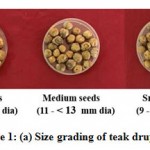 |
Figure 1: (a) Size grading of teak drupes |
Cutting Test
Cutting test was made grade wise and two hundred drupes were soaked in water for 24 hour and then individually cut form horizontally with the help of areca nut cutter. The empty locules, one seeded, two seeded, three seeded and four seeded drupes were counted and mean numbers recorded. The fillingness was expressed as percentage Fig 1 (b).
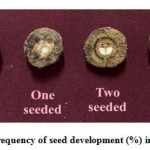 |
Figure 1: (b) Frequency of seed development (%) in teak drupes |
Drupe Germination Test
The drupes were subjected to soaking in water followed by drying at 12 hours interval for 6 days and 7th day the pre-conditioned drupes were placed for germination in sand taken in earthen pots (30 cm height and 30 cm upper width) and kept in open sun light. Experiment was conducted in Completely Randomized Design and 10 replications of 30 drupes were used in all grads. A germination period of 28 days as recommended by13 was adopted. Time taken for initial emergence was observed. The normal seedlings (one (or) more) produced by single drupe was counted as one seedling and germination (expressed as percentage) was computed, total number of seedlings produced by 30 drupes were also counted and the mean value was expressed as 100-1. For the estimation of dry matte production, ten seedlings were selected at random and kept in a hot air oven maintained at 85oC for 24 hours after measuring their root and shoot length. The vigour index was derived from the formula14.
VI=Percent germination X Total seedling length (cm)
True Seed Extraction
The true seeds were extracted grade wise with a wooden mallet; the seeds located inside the locules of the fruit were removed carefully without any damage to the cotyledon and seed coat. After extracting the true seeds from the fruit, weighed 100 true seed weigh (g) grade wise. Those seed only used for in vitro germination studies Fig 1 (c).
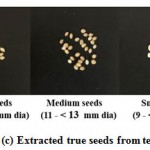 |
Figure 1: (c) Extracted true seeds from teak drupes |
Media Preparation for in vitro Germination
To perform in vitro germination, half strength MS media was prepared by adding 50 % of the recommended dose of macro, micro and minor elements of the MS medium15. Full strength of vitamins, 3 % Sucrose and 0.22 µM BAP was added to the medium and the pH was adjusted to 5.8. After pH adjustment 0.8 % agar was added, and the media was melted to homogenize the agar. The melted media was evenly distributed in to culture bottles up to 50 ml per vessel. Finally, the culture vessels with media was autoclaved at 121°C plus 15 psi pressure for 20 minutes.
Sterilization and Inoculation of True Seeds
Each grade of the true seeds was dried for 1 hour in sun light prior to sterilization. The seeds were placed in distilled water containing 0.1 % Bavistin and 0.1 % Tween 20 for five minutes with constant shaking. After Bavistin treatment the seeds were washed in tap water for one minute and washed in 70 % ethanol for 30 seconds. After ethanol wash the true seeds were washed with sterile distilled water. Now the seeds were sterilized in 0.1 % mercuric chloride (HgCl2) solution for five minutes with constant shaking. After HgCl2 sterilization the true seeds have been washed three times with sterile distilled water.
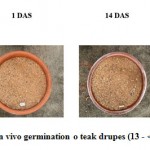 |
Figure 2: In vivo germination o teak drupes (13 – <15 mm dia.) |
In Vitro True Seed Germination Test
The sterilized seeds were carefully inoculated in to a half MS media bottle under a laminar airflow chamber by following the ascetic techniques. Six seeds were inoculated per bottle and eight replicates were made for each treatment. Then the culture vessels were placed in a primary growth room maintaining 25°C temperature, 16 hours light and 8 hours dark conditions. Once in a day the in vitro seed inoculates were observed for time taken for initial emergence and germination percent were taken 14 and 28 days after sowing13. fig. 3 For the estimation of dry matte production, three seedlings were selected at random and kept in a hot air oven maintained at 85oC for 24 hours after measuring their root and shoot length. The vigour index was derived from the formula14.
VI=Percent germination X Total seedling length (cm)
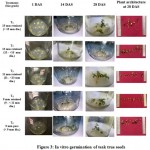 |
Figure 3: In vitro germination of teak true seeds |
Statistical analysis
The results were subjected to analysis of variance and tested (t-test) for significant difference (p=0.05) as suggested16. Percentage values were transformed into arc sine values prior to statistical analysis.
Results and Discussion
Size grading on seed filling
Effect of drupe size and germination of teak revealed that significant difference was found among the treatments. The large sized drupes with 15 mm diameter recorded highest 100 drupe weight of
105.19 g and drupe diameter of 14.16 mm followed by 13 – < 15 mm retained had 76.68 g
100 drupe weight and 12.67 mm drupe diameter, 11 – < 13 mm retained had 58.18 g
100 drupe weight and 11.28 mm drupe diameter, 9 – < 11 mm retained had 55.95 g
100 drupe weight and 10.28 mm drupe diameter and 9 mm passed drupes recorded lowest 100 drupe weight of 42.79 g and drupe diameter of 9.47 mm. When seed filling percent of 15 mm retained recorded highest seed filling of 68 % with a greater number of two seeded drupes, followed by 13 – < 15 mm retained drupes recorded 62 % seed filling, 9 – < 11 mm retained drupes recorded 60 % seed filling, 9 mm pass 58 % and 11- <13 mm retained 54 % seed filling with a greater number of single seeded drupes compared to 15 mm retained (Table 1 and Fig 4). These results indicated that the number of seeds per drupe was not found to decrease with decreasing drupe size.
Table 1: Effect of drupe size on frequency of seed development (%) in teak drupes
| Treatments
(Size grade) |
No. of seeds/drupe | |||||
| Empty | One | Two | Three | Four | Seed filling | |
| T1
15 mm retained (> 15 mm dia.) |
32
(34.45) |
22
(27.97) |
40
(39.23) |
6
(14.17) |
0
(0.286) |
68
(55.55) |
| T2
13 mm retained (13 – < 15 mm dia.) |
38
(38.05) |
40
(39.23) |
22
(27.97) |
0
(0.286) |
0
(0.286) |
62
(51.94) |
| T3
11 mm retained (11- < 13 mm dia.) |
46
(42.70) |
42
(40.39) |
8
(16.43) |
4
(11.53) |
0
(0.286) |
54
(47.29) |
| T4
9 mm retained (9 – < 11 mm dia.) |
40
(39.23) |
50
(45.00) |
10
(18.43) |
0
(0.286) |
0
(0.286) |
60
(50.76) |
| T5
9 mm pass (< 9 mm dia.) |
42
(40.39) |
54
(47.29) |
4
(11.53) |
0
(0.286) |
0
(0.286) |
58
(49.60) |
| Mean | 39.6
(38.64) |
41.6
(39.81) |
16.8
(23.57) |
5
(12.92) |
0
(0.286) |
60.4
(50.76) |
| SEd | 0.617 | 0.523 | 0.083 | 0.033 | – | 0.583 |
| CD (P= 0.01) | 1.819 | 1.542 | 0.246 | 0.100 | – | 1.720 |
(Figures in parentheses indicate arc sine value)
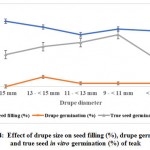 |
Figure 4: Effect of drupe size on seed filling (%), drupe germination and true seed in vitro germination (%) of teak |
Size grading on drupe in vivo germination
The results of drupe weight showed that 100 drupe weight decreases with decrease in drupe diameter. Variation in drupe seed germination per cent, root length, shoot length, number of leaves per seedling, seedling dry matter production and vigour index was observed among the different groups of size graded seeds. 13 – < 15 mm retained showed highest drupe germination of 10 % followed by 11- < 13 mm retained, 9 – < 11 mm retained, 9 mm pass had 3.3 % of germination and none of the drupes was germinated in 15 mm retained. In case of root length 9 – < 11 mm retained drupes showed highest root length of 2.5 cm followed by 2.4 cm of 13 – < 15 mm retained, 2.2 cm 11- < 13 mm retained, 2.0 cm of 9 mm pass drupes. 9 mm pass drupes had highest shoot length of 4 cm followed by 3.5 cm of 13 – < 15 mm retained, 3.4 cm of 11 – < 13 mm retained, 1.8 cm of 9 – < 11 mm retained drupes. 11 – < 13 mm retained showed highest total number leaves (6) followed by (4) 13 – < 15 mm retained; 9 – < 11 mm retained (2) of 9 mm pass drupes. 13 – < 15 mm retained drupes showed highest dry matter production on 0.068 g followed by 0.025 g of 9 – < 11 mm retained drupes, 0.019 g of 9 mm pass drupes and 0.017 g of 11- < 13 mm retained drupes had lowest dry matter. 13 – < 15 mm retained drupes recorded highest vigour index of 59 followed by 19.8 of 9 mm pass, 18.48 of 11- < 13 mm retained drupes and 9 – < 11 mm retained drupes recorded lowest vigour index of 14.19 (Table 2 and Fig 4). These results showed that the drupe size and filling per cent were found to be negatively correlated with drupe germination in teak.
Table 2: Effect of drupe size on 100 drupe weight, drupe diameter, germination and seedling vigour of teak.
| Treatments | 100 drupe weight
(g) |
Drupe diameter
(mm) |
Days taken for initial emergence | 14 DAS
Germination (%) |
28 DAS | |||||
| Germination (%) | Root length (cm) | Shoot length (cm) | No. of leaves | Dry matter production
(mg/10 seedlings) |
Vigour index | |||||
| T1
15 mm retained (> 15 mm dia.) |
105.19 | 14.16 | – | 0
(0.286) |
0
(0.286) |
0 | 0 | 0 | 0 | 0 |
| T2
13 mm retained (13 – < 15 mm dia.) |
76.68 | 12.67 | 15 | 0
(0.286) |
10
(18.43) |
2.4 | 3.5 | 4 | 0.068 | 59.0 |
| T3
11 mm retained (11- < 13 mm dia.) |
58.18 | 11.28 | 21 | 0
(0.286) |
3.3
(9.97) |
2.2 | 3.4 | 6 | 0.017 | 18.48 |
| T4
9 mm retained (9 – < 11 mm dia.) |
55.95 | 10.28 | 22 | 0
(0.286) |
3.3
(9.97) |
2.5 | 1.8 | 4 | 0.025 | 14.19 |
| T5
9 mm pass (< 9 mm dia.) |
42.79 | 9.47 | 17 | 0
(0.286) |
3.3
(9.97) |
2.0 | 4..0 | 2 | 0.019 | 19.8 |
| Mean | 67.7 | 11.8 | 15 | 0
(0.286) |
3.98
(9.97) |
1.82 | 2.54 | 3.2 | 0.025 | 22.29 |
| SEd | 0.890 | 0.121 | 0.306 | – | 0.089 | 0.026 | 0.016 | 0.069 | 0.0006 | 0.548 |
| CD (P= 0.01) | 2.623 | 0.358 | 0.901 | – | 0.264 | 0.078 | 0.047 | 0.204 | 0.0018 | 1.615 |
(Figures in parentheses indicate arc sine value) DAS Days after sowing
Size Grading on In Vitro True Seed Germination
The true seeds were extracted from five diameter groups of teak drupes based on their size grades. 15 mm retained had the highest 100 true seed weight of 1.78 g followed by
13 – < 15 mm retained (1.58 g), 11- < 13 mm retained (1.48 g), 9 – < 11 mm retained (1.34 g) and
9 mm pass (1.21 g). These results clearly indicated that decreases in drupe weight with decrease in true seed weight.
True seeds of different grades were germinated in half MS media under in vitro condition and observed for 14 and 28 days after sowing. Variation in true seed germination per cent, root length, shoot length, number of leaves per seedling, seedling dry matter production and vigour index was observed among the different groups of size graded seeds. 9 – < 11 mm retained showed highest in vitro germination per cent of 50.0 % at 14 days after sowing (DAS), and 54.1 % germination in 28 DAS. The 11- < 13 mm retained group recorded 41.6 % germination at 14 DAS and 45.8 % germination at 28 DAS, 13 – < 15 mm retained group showed 33.3 % germination in 14 DAS and 41.6 % germination in 28 DAS, 15 mm retained group had 33.3 % germination in 14 DAS and 33.3 % germination in 28 DAS. Very small seed group of 9 mm pass had lowest germination value of 25 % in in vitro conditions at 14 DAS and 29.1 % germination at 28 DAS.
11 – < 13 mm retained showed highest root length of 2.95 cm followed by 2.81 cm for 13 – < 15 mm retained, 2.68 cm for 9 mm pass, 2.1 cm for 15 mm retained and 9 – < 11 mm retained had lowest root length value of 2.0 cm. 15 mm retained recorded highest shoot length of 2.25 cm followed by 2.03 cm for 9 – < 11 mm retained, 2.02 cm for 9 mm pass, 1.77 cm for 11- < 13 mm retained and 13 – < 15 mm retained had lowest shoot length value of 1.56 cm. 15 mm retained showed highest number of leaves per plant (4.20) followed by (3.91) for 9 mm pass, (3.62) for 9 – < 11 mm retained, (3.0) for 13 – < 15 mm retained and 11- < 13 mm retained had lowest number of leaves (2.75) compare to all treatments. 9 – < 11 mm retained had highest seedling vigour with a vigour index value of 218.02, followed by 216.17 for 11- < 13 mm retained, 181.79 for 13 – < 15 mm retained, 144.85 for 15 mm retained and 136.77 for 9 mm pass (Table 3 and Fig 4). These results showed that the drupe size and filling per cent were found to be negatively correlated with in vitro germination in teak.
Table 3: Effect of drupe size on 100 true seed weight and in vitro germination and seedling vigour of true seeds of teak
| Treatments | 100 true seed weight
(g) |
Days taken for initial emergence | 14 DAS
Germination (%) |
28 DAS | |||||
| Germination (%) | Root length (cm) | Shoot length (cm) | No. of leaves | Dry matter production
(mg/10 seedlings) |
Vigour index | ||||
| T1
15 mm retained (> 15 mm dia.) |
1.78 | 4 | 33.3
(35.06) |
33.3
(35.06) |
2.1 | 2.25 | 4.20 | 86 | 144.85 |
| T2
13 mm retained (13 – < 15 mm dia.) |
1.58 | 8 | 33.3
(35.06) |
41.6
(39.81) |
2.81 | 1.56 | 3.0 | 83 | 181.79 |
| T3
11 mm retained (11- < 13 mm dia.) |
1.48 | 5 | 41.6
(39.81) |
45.8
(42.13) |
2.95 | 1.77 | 2.75 | 69 | 216.17 |
| T4
9 mm retained (9 – < 11 mm dia.) |
1.34 | 5 | 50.0
(45.00) |
54.1
(47.29) |
2.0 | 2.03 | 3.62 | 78 | 218.02 |
| T5
9 mm pass (< 9 mm dia.) |
1.21 | 4 | 25.0
(30.00) |
29.1
(32.58) |
2.68 | 2.02 | 3.91 | 52 | 136.77 |
| Mean | 1.47 | 5.2 | 36.64
(36.87) |
40.78
(39.23) |
2.50 | 1.92 | 3.49 | 73.6 | 179.52 |
| SEd | 0.023 | 0.06 | 0.44 | 0.59 | 0.03 | 0.02 | 0.06 | 0.663 | 1.94 |
| CD (P= 0.01) | 0.068 | 0.13 | 0.93 | 1.26 | 0.06 | 0.05 | 0.13 | 1.955 | 4.14 |
The present results were not agreed with earlier studies indicated that larger drupe size in teak have better germination17,18,19. Size of the drupe is primary factors for determining germination per cent20. The results confirm that the variability between different population within the species in seed characters and germination percentage is due to strong genetic influence21,22,23. In earlier studies showed that number of seeds per drupe was found to decrease with drupe size24,25,26. The drupe weight and endocarp weight that are positively correlated with filling per cent but not significantly correlated with germination per cent25. the higher endocarp ash may due to the presence of higher inorganic compounds like calcium which can help to increase cell wall rigidity and thickness and it may affect germination27. While, direct correlation of mesocarp weight on germination was found to be negatively correlated. High mesocarp proportion affects germination because of more phenolic content is present 28,29,30. Present studies also confirm that the larger drupe size has no relation with germination, confirm the results of31,32,33. There was strong interaction between survival rate and seedling growth under in vitro and in vivo condition. Better seedling growth and survival rate of 9 – < 11 mm retained drupes (true seeds) under in vitro compare to in vivo condition, it confirming the result of 26.
In the present study reveals that the average seed filling percentage was 60.4, irrespective of the size of the drupe were studied, where as in an average germination of drupe only 3.98 percent, when the drupe was placed for germination in sand method. Whereas the true seeds were extracted from the drupe and placed for germination in in vitro condition in half MS medium recorded 40.78 percent, around 36.8 percent higher than the drupe germination. Improved germination in MS medium is not well understood. It is assumed that the nutrient composition of the media might be enhanced the germination of true seed. Poor germination of whole drupe might be due to physical25, Physiological6 and morpho-physiological dormancy34. There is contradictory view regarding physical dormancy the report7, demonstrates that teak drupes generally have mechanical not physical dormancy. The above findings supported with the present study, where the true seed extracted from the drupe enhanced the germination when compared to sowing the drupe as it is. The endocarp of the drupe might be given the mechanical resistance to the germinating seed. In the present study, true seed recorded only 40.78 present germination the remaining un-germinated true seed may have been affected by morphological embryo dormancy11,35,7. It need in-depth study regarding the germination behavior of true seed.
Conclusion
From this study it could be concluded that 15 mm retained drupes had highest 100 drupe weight, 100 true seed weight and seed filling but it has negatively correlated with germination. In in vitro condition 9 – < 11 mm retained drupes (true seeds) recorded highest germination compared to all other grades. It is clearly indicated that small size grades seeds also give highest germination compared to large grade drupes. This study useful for the precious genetically improved small size seed useful for establishing large scale teak plantations.
Acknowledgement
The authors are thankful to Anbil Dharmalingam Agricultural College and Research Institute, Tamil Nadu Agricultural University, Trichy, Tamil Nadu for the facilities provided.
Conflict of Interest
We confirm that we do not have any conflict of interest.
Funding Source
The study was funded by Tamil Nadu Agricultural University Core resources.
References
- Troup R. S., The Silviculture of Indian Trees. Oxford Press. 1921; 1184.
- FAO. Global teak trade in the aftermath of Myanmar’s log export ban by Kollert, W. & Walotek, P.J. Planted Forests and Trees Working Paper FP/49/E. Rome, Italy, 2015.
- Jha K. K. Teak (Tectona grandis) Farming International Book distributing company, Lucknow. 1999; 125.
- Masilamani P., Dharmalingam C. Influence of Seed Treatment with Potassium Nitrate on Germination and seedling vigour of Teak (Tectona grandis Linn.f). Indian Journal of Forestry. 1999; 22:1-6.
- Harper J. C., Obeid M. Influence of seed size and depth of sowing an establishment and growth of varieties of fiber and oil seed flax, Crops science. 1967; 7:527-532.
CrossRef - Masilamani P., Dharmalingam C., Annadurai K. Provenance variation in seed and seedling attributes of Teak (Tectona grandis linn.f). In “Proceedings of the International Workshop on Production and Marketing of Teak Woods: Future Scenarios” edited by K.Jayaraman, M.Balasundaran, K.V.Bhat and C.N. Krishnankutty. Workshop held during 23-25, November, 2009 at Kerala Forest Research Institute, Peechi, Kerala. India. 2009; 90-97.
- Slator J. N., Callister N. A., Doland Nichols J. Mechanical but not physical dormancy is a cause of poor germination in teak (Tectona grandis L. f), New forest. 2013; 44:39-44.
CrossRef - Hartmann, H. T., Kester D. E., Davies F. T., Geneve R. L. Plant propagation: principles land practices, prentice Hall, Upper Saddle River 1997.
- Agboola D. A. Studies on the germination inhibitors in the fruits of four tropical tree species. Glob J Pure App Sci. 2000; 6:27-30.
CrossRef - Joshi M. D., Kelkar S. P. Germination of seeds in dry teak (Tectona grandis L.) preliminary studies in fruit development and seed dormancy, Indian For. 1971; 97:210-216.
- Dabral S. L. Extraction of teak seed from fruit, their storage and germination. India Forester. 1976; 102: 650-658.
- Suangtho V. Factors controlling teak (Tectona grandis Linn. f.) seed germination and their importance to Thailand. Masters Thesis, Australian National University, Canberra. 1980.
- International Seed Testing Association.,. International rules for seed testing, Seed Science and Technology. 1985; 13:229-355.
- Abdul Baki A. A., Anderson J. D. Vigour determination in soybean seed by multiple criteria. Crop Sci. 1973; 13:630-633.
CrossRef - Murashige T., Skoog F. A Revised medium for rapid growth and bio assays with tobacco tissue cultures, Physiological Plantarum. 1962; 15:473-497.
CrossRef - Panse V. G., Sukhatme P. V. Statistical methods for agricultural workers. Indian Council of Agricultural Research Publications, New Delhi. 1995; 330.
- Samapudhi K. A Country Report on Teak in Thailand. FAO Forestry Paper, Rome. 1967; 7.
- Kumar A. Effect of fruit size and source on germination of teak seeds, Sri Lanka forester. 1979; 14:58-63.
- Syam V. Investigations on production of healthy seedlings of teak in the nursery. M.Sc. thesis, College of Forestry, Kerala Agriculture University, Kerala, India. 1988; 136.
- Banik R. L. Studies on grading of teak fruits II. Combined effect of fruit weight and size on the production of seedling. Bano Bigyan Patrika. 1978; 7:20-29.
- Hellum A. K. Grading seed by weight in white spruce, Tree Planters’ Notes. 1976; 27:16-17.
- Bagchi S. K., Joshi D. N., Rawat D. S. Variation in seed size of Acacia spp. Silvae Genetica. 1990; 39:107–110.
- Vakshasya R. K., Rajora O. P., Rawat M. S. Seed and seedling traits of Dalbergia sissoo Roxb. seed source variation among ten sources in India, Forest Ecology and Management. 1992; 48:265-275.
CrossRef - Banik R. L. Studies on grading of teak fruits – I. Fruit size is a factor in germination of teak seeds. Bano-Biggyan-Patrika. 1997; 6(1):1-7.
- Sivakumar V., Parthiban K. T., Singh B. G., Gnanambal V. S., Anandalakshmi R., Geetha S. Variability in drupe characters and their relationship on seed germination in Teak (Tectona grandis L. f.), Silvae genetica. 2002; 5:232-236.
- Akram M., Aftab F. Fruit size and sampling sites effect on dormancy, viability and germination of teak (Tectona grandis L.) seeds. Pakistan Journal of Botany. 2016; 48:511-518.
- Schroeder C. A. Progress report on study of sclereid formation in Avocado fruit pericarp. California Avocado Society Yearbook. 1982; 66:161-165.
- Bhumibhamon S., Ponoy B., Chaisurisri K. Publicacion-Especial-Instituto-Nacional-de-Investigaciones-Forestales, Mexico. 1983; 35:253-264.
- Chacko K. C. Termite-aided mesocarp removal of teak (Tectona grandis L. f.) fruits for enhanced germination and cost- effective seed handling, Indian Forester. 1998; 124:134-140.
- Bapat A. R., Phulari M. M. Teak fruit treatment machine – A Prototype – II, Indian Forester. 1995; 121:545-549.
- Jayasankar S., Babu L. C., Sudhakara K., Unnithan V. K. G. Provenance variation in seed and germination characteristics of teak (Tectona grandis L. f.), Seed Science and Technology. 1999; 27:131-139.
- Indira E. P., Basha C. S., Chacko K. C. Effect of seed size grading on the germination and growth of teak (Tectona grandis L. f.) seedlings, Journal of Tropical Forest Science. 2000; 12:21-27.
- Jose S., Indira E. P. Variability of seed related characters in teak (Tectona grandis L f) from Western Ghat region, Gregor Mendel Foundation Journal. 2010; 1:39-44.
- Gupta B. N., Pathanath P. G. Factors affecting germination of teak seeds of eighteen Indian Orgins, Indian Forester. 1975; 101:584-587.
- Masilamani P. Seed technological studies in teak (Tectona grandis Linn.f) Ph.D. Thesis. Tamil Nadu Agricultural University, Coimbatore, Tamil Nadu. 1996:187.

This work is licensed under a Creative Commons Attribution 4.0 International License.





